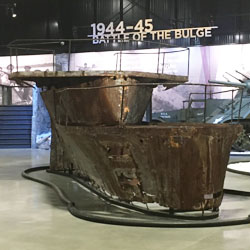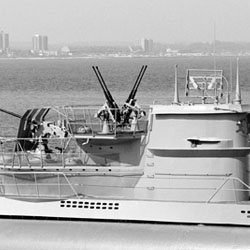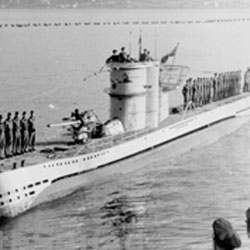The German U-boat Type VII was the backbone of the German navy, the Kriegsmarine, from its inception in 1936 until the end of WWII in 1945. There were a total of six different types of U-boat that saw combat in the Battle of the Atlantic during WWII, and they include the type VIIA, VIIB, VIIC, VIIC/41, VIID, and the VIIF. Of these, the VIIA, VIIB, VIIC, and VIIC/41 were all attack submarines, the VIID specialized in mine laying, and the VIIF was initially designed to be able to resupply other U-boats at sea with torpedoes when needed, but due to unsuccessful transfer methods it was very quickly changed to operate as a transport ship. Of the 709 type VIIs made during the war, 10 were VIIAs, 24 were VIIBs, 665 were type VIICs and its variants, six were VIIDs, and four were VIIFs.
Before WWII started the head of the U-boat arm Karl Donitz staked that the Kriegsmarine should focus their resources on building submarines, but Kriegsmarine commander Erich Raeder disagreed because he, along with most military pundits at the time, viewed submarines as cowardly. In January 1939 Hitler approved of Plan Z, a sprawling plan that would see the Kriegsmarine build a navy similar in structure and size to that of the British, which meant a balanced fleet, and not a submarine focused one as Donitz would have preferred.
Despite the differing opinions on how the Kriegsmarine should be structured, all agreed on the overarching strategy: attack British merchant ships and convoys to strangle the island country of England and force them to leave the war early due to a lack of supplies. Plan Z was set to be finished by 1948, the year both British and German intelligence speculated would be the earliest the Kriegsmarine could rearm to the size of the British navy. When war suddenly erupted in September 1939, just six months after the plan was approved, all the Kriegsmarine had been able to do in executing Plan Z was laying down the hulls of two ships.
Due to the unexpected outbreak of war and the infant state of Plan Z, the plan was scrapped and Germany focused exclusively on producing U-boats. According to Donitz, the Kriegsmarine needed 300 U-boats at the start of the war in order to successfully strangle the British of resources and force them to surrender. Due to their pre-war focus on building exclusively pre-war ships, only a total of 65 U-boats were in service at the onset of the war.
The main battle philosophy of the U-boat arms during the Battle of the Atlantic was to use “wolfpack tactics” in which groups of 5-10 U-boats would ambush merchant ships. This was particularly effective at the beginning of the war, when the conventional attack tactics of submarines was known to consist of submarines attacking alone. U-boats would use the then newly developed technology of radar on the surface to detect an oncoming convoy, then submerge, and then attack with their torpedoes.
These wolfpack tactics were wildly successful at the beginning of the war. The success of the U-boats would be categorized in two periods, later known as the First Happy Time and the Second Happy Time. The First Happy Time came in the summer of 1940 right after the fall of France in which U-boats situated in the Atlantic sunk 282 allied ships for a total loss of almost 1.5 million tons of merchant cargo between July and October 1941. The First Happy Time came to a close when the British made a change in their tactics concerning merchant ships, namely the addition of naval ships to escort merchant convoys. This resulted in a number of U-boat losses who among those included Germany’s three leading ace commanders that were paraded as German war heroes: Gunther Prien, Joachim Schepke, and Otto Kretschmer.
The Second Happy Time came in the beginning of 1942, after Germany declared war on the United States. U-boat forces traveled as far as the coast of New York City to take advantage of the weak presence the US had in the Atlantic due to the war against Japan in the Pacific as well as due to the Lend-Lease Program instituted by Roosevelt in 1941 and sink as many merchant convoys as possible. From January to August 1942 U-boats were able to sink over 600 Allied merchant ships totaling over 3 million tons.
Improvements in allied tactics and technology, such as widening distance between ships in convoys, developing an allied version of radar, increasing range for land based airplanes further into the pacific, and breaking the Enigma Code allowed the Allied forces to defend merchant shipping and sink many U-boats, and in 1943 when Donitz finally had the 300 U-boats he claimed necessary to choke England and win the economic war the Kriegsmarine had already effectively lost the Battle of the Atlantic. In total 783 U-boats were sunk during the course of the war.
The American Heritage Museum acquired the rear gun platform originally from a Type VII U-boat in eastern Europe and is now on display. This Type VII conning tower segment is the only example in the United States.







